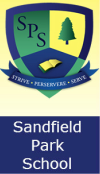AAC
At Sandfield Park School we have several children who have Complex Communication Needs (CCN) and use Alternative Augmentative Communication (AAC) to communicate. The route for identification of potentially benefiting from AAC to support communication either comes from primary school within their EHCP, or via our annual review process with parents, when it is discussed they are having some difficulties communicating their thoughts, wants and needs.
We want our pupils to be confident and competent to talk to anyone about any topic, so they can be safe in the community be, in the future, capable of being in a work place. We have a total immersion approach to supporting our young people to be able to communicate, by always using their method of communication to talk to them, modelling language and providing aided language stimulation. It is well known that being able to communicate using AAC is the same as learning a new language, so it is important for everyone around them to accept their method of communication, and communicate back with them in the same way. We have a core word each week which pupils will be shown how to use in a variety of contexts, in the hope they will be able to generalise this skill in the future and use it spontaneously. All AAC users receive AAC interventions from our communication assistants within school, as well as being supported in class, and during unstructured social times, such as break time and lunch time. Our AAC activity packs are sent home weekly and feature an activity for our pupils to do with their communication partners at home, as well as having access to Boardmaker Online, which has weekly content uploaded to each pupil’s area with books, activities focussed on the core word of the week.
A current focus is peer to peer communication, as we have identified this is something which most of our young people struggle with and is an important part of school and future life.
We want our pupils to be confident and competent to talk to anyone about any topic, so they can be safe in the community be, in the future, capable of being in a work place. We have a total immersion approach to supporting our young people to be able to communicate, by always using their method of communication to talk to them, modelling language and providing aided language stimulation. It is well known that being able to communicate using AAC is the same as learning a new language, so it is important for everyone around them to accept their method of communication, and communicate back with them in the same way. We have a core word each week which pupils will be shown how to use in a variety of contexts, in the hope they will be able to generalise this skill in the future and use it spontaneously. All AAC users receive AAC interventions from our communication assistants within school, as well as being supported in class, and during unstructured social times, such as break time and lunch time. Our AAC activity packs are sent home weekly and feature an activity for our pupils to do with their communication partners at home, as well as having access to Boardmaker Online, which has weekly content uploaded to each pupil’s area with books, activities focussed on the core word of the week.
A current focus is peer to peer communication, as we have identified this is something which most of our young people struggle with and is an important part of school and future life.

